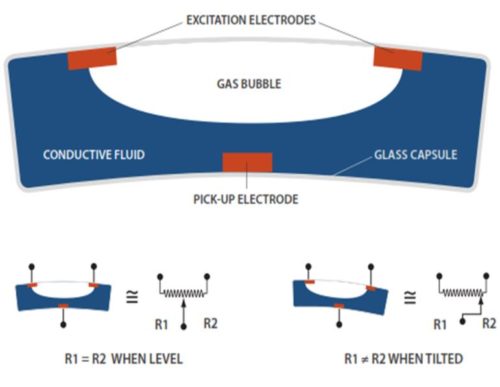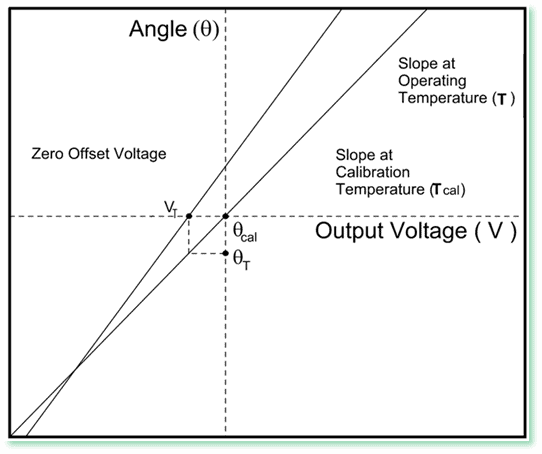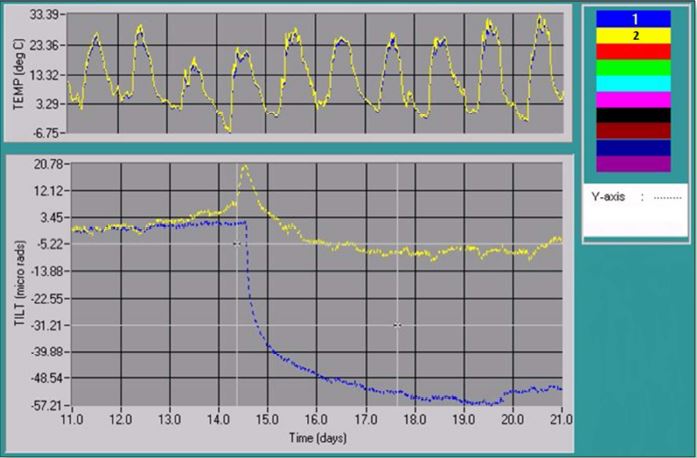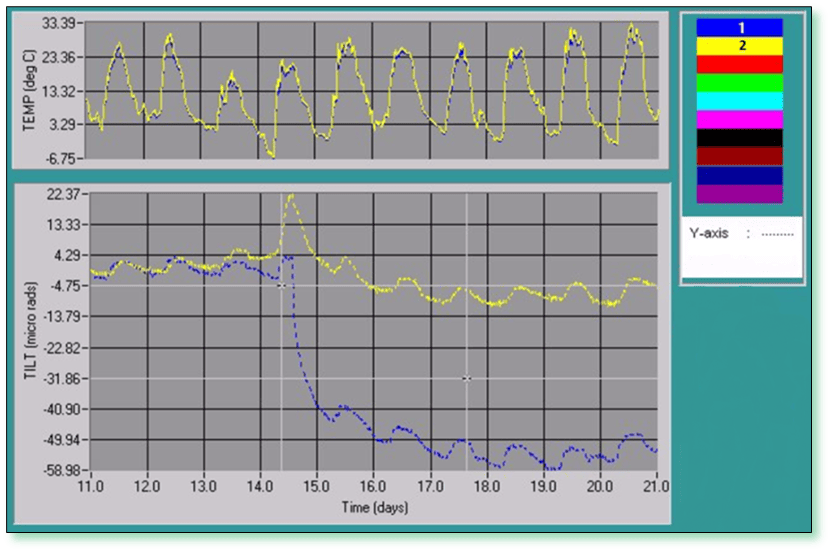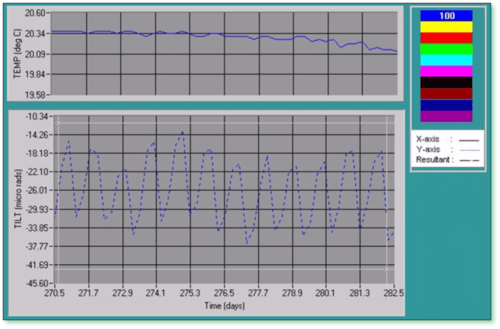Environmental temperature changes alter the mechanical and electrical characteristics of all instrumentation. Metals expand and contract, and electrical properties such as resistance and capacitance rise and fall. These effects change instrument output and lessen the accuracy of the measured variable (pressure, flow, tilt, strain, etc.). This technical note describes the source of temperature dependence in one type of instrumentation, Jewell Instruments electrolytic tiltmeters, and explains how to remove this effect to maximize accuracy. The principles presented here also apply to many other instrument types.
Just as instrumentation exhibits temperature-dependent behavior, so too do natural and engineered structures including slopes, embankments, and concrete and steel construction. Thermal expansion and contraction in response to daily and seasonal temperature fluctuations generate real movements that are detected by tiltmeters and other sensors. The magnitude of this effect, and ways of differentiating it from purely instrumental behavior, are discussed in this article.
Sources Of Temperature Coefficients
The sensors in Jewell Instruments Geotech/Tech tiltmeters are known as electrolytic tilt sensors, a type of electronic spirit level comprised of a glass case and containing a conductive liquid (electrolyte), an air bubble, and platinum electrodes. As the sensor tilts, the wetted area of each excitation electrode increases or decreases, depending on the tilt direction. This change causes the electrical resistance between the central pickup electrode and each excitation electrode to rise or fall. It is these resistance changes that are sensed by the tiltmeter electronics, which convert them to precise measurements of the magnitude and direction of tilt.
Temperature fluctuations cause thermal expansion and contraction of the sensor liquid, shrinking or swelling the air bubble and changing the amount of liquid in contact with each excitation electrode. This process alters the scale factor (gain) of the sensor and can shift its zero point. Small changes in sensor output in the absence of any real tilt movement are the result. Experiments have shown that volumetric expansion and contraction of the liquid is the single biggest source of temperature coefficients in Jewell Instruments electrolytic tiltmeters. This effect is much greater than dimensional changes of the sensor’s glass case, which has a thermal expansion coefficient 100 times smaller than that of the liquid.
Thermoelasticity of the tiltmeter housing, and of the mechanical connections between housing and sensor, is another source of tiltmeter zero shift. To minimize this effect, rigid housings are used and connections between the sensor and enclosure are made as few as possible. In many designs we pot the tilt sensor directly into the housing base, eliminating mechanical connections entirely and turning the sensor and base into one unified element.
The temperature effects described above are partially removed (compensated) by the tiltmeter’s electronic circuitry. The apparent tilt (residual error) remaining after such compensation is highly repeatable and is described by two linear temperature coefficients, the temperature coefficient of scale factor, KS, and the temperature coefficient of zero shift, KZ. These coefficients include contributions from all sources, including the tiltmeter electronics.
There is one additional effect of temperature on electrolytic tilt sensors. The conductivity of the electrolyte changes more than five-fold over the typical operating range of a tiltmeter (typically -40°C to +70°C). By measuring sensor output ratiometrically (taking output as a percentage of input), Jewell Instruments electrolytic tiltmeters remove this effect entirely. However, in designs that incorporate the sensor as part of a Wheatstone bridge, electrolyte conductivity change can be a major source of measurement error.
Temperature Coefficients Defined
Scale factor is the proportionality constant between tilt angle and tiltmeter output. It is determined in the factory by calibrating the tiltmeter – rotating it through a range of known angles and recording the output voltage at each angle. The slope of the best-fit straight line through the calibration data is the scale factor Scal that is reported on the tiltmeter calibration certificate. In reality, the slope is slightly different at each temperature.
Equation 1:
The change of slope per unit temperature change is the temperature coefficient of scale factor where Scal is the scale factor at the calibration temperature Tcal, and S is the scale factor at a different temperature T.
The temperature change can also shift the zero crossing of the calibration line in the absence of any real tilt of the structure to which the tiltmeter is attached. In the graph, the zero offset voltage is VT which leads to an apparent tilt angle of q = ScalVT at temperature T. The zero shift is therefore q – q cal or ScalVT – q cal. The zero shift per unit temperature change is defined as the temperature coefficient of zero shift, Kz.
Equation 2:
The coefficients KS and KZ are determined in the laboratory by performing calibrations at two or more temperatures and include contributions from all sources. Their values are specific to each of the several classes of tiltmeters made by Jewell Instruments and are available on request. For tiltmeters with the designation “high gain,” the ones most typically used in geotechnical engineering, KS @ +0.0004/°C and KZ @ 1.5µradian/°C (= 0.2 arcsecond/°C). Temperature coefficient values should decline in the future as sensor and electronic designs advance.
Equations For Temperature Compensation
Equation 3:
For uncompensated tiltmeter measurements, the tilt angle q is simply q = ScalV where V is the measured voltage and Scal is the scale factor measured at the calibration temperature Tcal. For measurements at all temperatures, Scal, the scale factor is first adjusted using the temperature coefficient KS before computing q.
Equation 4:
The zero offset is then removed using the temperature coefficient Kz and the true compensated tilt angle qcomp is computed using Equation 5. Where
Equation 5:
| qcomp | = true angular position (tilt) |
| T | = the temperature at which your measurement was made |
| Tcal | = the calibration temperature reported on the tiltmeter calibration certificate |
| S | = scale factor at temperature T |
| Scal | = the scale factor reported on the tiltmeter calibration certificate |
| V | = the measured output voltage at temperature T |
Equation 6:
Inserting Equation 4 into Equation 5, and expanding results in Equation 6.
Recognizing that ScalV is the uncompensated angle q, we can rewrite Equation 6 as
q comp= q + q • Ks( T – Tcal ) – Kz( T – Tcal ).
Equation 7:
Equation 7 intuitively shows the compensation of the angular measurement consists of the uncompensated angular measurement, a slope compensation term that scales the uncompensated angular measurement and a zero offset term that is dependent on temperature only.
Finally, this temperature compensation procedure is an option for all Jewell Instruments electrolytic digital tiltmeters. It may also be incorporated into spreadsheets and other user-written programs.
